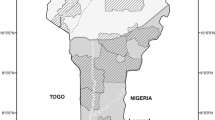Abstract
Homegardens in Kerala have long been important multi-purpose agroforestry systems that combine ecological and socioeconomical sustainability. However, traditional homegardens are subject to different conversion processes linked to socioeconomic changes. These dynamics were studied in a survey of 30 homegardens. On the basis of a cluster analysis of tree/shrub species density and subsequent further grouping using homegarden size as additional characteristic, six homegarden types were differentiated. These were assessed regarding structural, functional, management and dynamics characteristics. Four development stages of homegardens were found along a gradient from traditional to modern homegardens. Fifty percent of the homegardens still displayed traditional features, whereas 33% incorporated modern practices. The process of modernisation includes a decrease of the tree/shrub diversity, a gradual concentration on a limited number of cash-crop species, an increase of ornamental plants, a gradual homogenization of homegarden structure and an increased use of external inputs. One homegarden was characterised as an adapted traditional homegarden combining multispecies composition and intensive management practices using internal inputs with commercial production. In comparison to modern homegardens, this homegarden type offers an example of an alternative development path in adapting homegardens to changing socioeconomic conditions. The study of structural and functional dynamics of homegardens offers the opportunity to understand the trends in socio-economic sustainability and how these relate to ecological sustainability.
Similar content being viewed by others
References
T. Abebe (2005) Diversity in Homegarden Agroforestry Systems of Southern Ethiopia Wageningen University the Netherlands
C. Ashley S. Maxwell (2001) ArticleTitleRethinking rural development Development Policy Review 19 IssueID4 395–425 Occurrence Handle10.1111/1467-7679.00141
L. Christanty O.S. Abdoellah G.G. Marten J. Iskander (1986) Traditional agroforestry in West Java: the pekarangan (homegarden) and kebun-talun (annual-perennial rotation) cropping systems G.G. Marten (Eds) Traditional Agriculture in Southeast Asiaa Human Ecology Perspective Westview Press Boulder and London 132–158
InstitutionalAuthorNameFAO (1977) FAO-UNESCO Soil Map of the World 1: 5000000. Volume VII, South Asia UNESCO France
I.D. Hoogerbrugge L.O. Fresco (1993) Homegarden Systems: Agricultural Characteristics and challenges International Institute for Environment and Development London, UK
Huston M.A. 1994. Biological Diversity. The Coexistence of Species on Changing Landscapes. Cambridge University Press, 681 pp.
J. John M.A. Nair (1999) ArticleTitleSocio-economic characteristics of homestead farming in south Kerala J. Tropical Agric. 37 107–109
D. Jose N. Shanmugaratnam (1993) ArticleTitleTraditional homegardens of Keralaa sustainable human ecosystem Agroforestry Syst. 24 203–213
B.M. Kumar S.J. George S. Chinnamani (1994) ArticleTitleDiversity, structure and standing stock of wood in the homegardens of Kerala in peninsular India Agroforestry Syst. 25 243–262
B.M. Kumar P.K.R. Nair (2004) ArticleTitleThe enigma of tropical homegardens Agroforestry Syst. 61 135–152
J.M. Leiva C. Azurdia W. Ovanda E. Lopez H. Ayala (2002) Contributions of homegardens to in situ conservation in traditional farming systems – Guatemalan component J.W. Watson P.B. Eyzaguirre (Eds) Homegardens and in situ Conservation of Plant Genetic Resources in Farming Systems International plant genetic resources institute IPGRI RomeItaly 56–72
V.E. Mendez R. Lok E. Somarriba (2001) ArticleTitleInterdisciplinary analysis of homegardens in Nicaragua: micro-zonation, plant usse and socioeconomic importance Agroforestry Syst. 51 85–96
G. Michon F. Mary (1994) ArticleTitleConversion of traditional village gardens and new economic strategies of rural household in the area of BogorIndonesia Agroforestry Syst. 25 31–58
M.A. Nair C. Sreedharan (1986) ArticleTitleAgroforestry farming systems in the homesteads of Keralasouthern India Agroforestry Syst. 4 339–363
P.K.R. Nair (2001) ArticleTitleDo tropical homegardens elude scienceor is it the other way around? Agroforestry Syst. 53 239–245
K.P. Ouseph (2002) Government Policies and legal issues in growing trees in homegardens of Kerala International Workshop, Agroforestry and Natural Resource Management2002 Centre for Rural Development and Appropriate Technology, Cochin University of Science and Technology, in association with IRTC Palakkad
C. Quiroz M. Gutierrez D. Rodriguez D. Perez J. Ynfante J. Gamez T. Fernandez Particlede A. Marques W. Pacheco (2002) Homegardens and in situ conservation of agrobiodiversity – Venezuelan component J.W. Watson P.B. Eyzaguirre (Eds) Homegardens and in situ Conservation of Plant Genetic Resources in Farming Systems International plant genetic resources institute IPGRI Rome, Italy 73–82
V. Santhakumar (2002) Biodiversity in homegardens, towards a viable conservation strategy International Workshop, Agroforestry and Natural Resource Management, 2002 Centre for Rural Development and Appropriate Technology, Cochin University of Science and Technology, in association with IRTC Palakkad
O. Soemarwoto (1987) Homegardens: a traditional agroforestry system with a promising future H.A. Steppler P.K.R. Nair (Eds) Agroforestry, a Decade of Development ICRAF Nairobi, Kenya 157–172
E. Torquebiau (1992) ArticleTitleAre tropical agroforestry homegardens sustainable? Agric. Ecosyst. Environ. 41 189–207
K.F. Wiersum (1982) ArticleTitleTree gardening and taungya on Java. Examples of agroforestry techniques in the humid tropics Agroforestry Syst. 1 53–70
K.F. Wiersum (1995) ArticleTitle200 years of sustainability in forestry: lessons from history Environ. Manage. 19 321–329
K.F. Wiersum (1997) ArticleTitleIndigenous exploitation and management of tropical forest resources: an evolutionary continuum in forest – people interactions Agric. Ecosyst. Environ. 63 1–16
K.F. Wiersum (2004) ArticleTitleForest gardens as an intermediate land-use system in the nature-culture continuum: characteristics and future potential Agroforestry syst. 61 123–134
K.F. Wiersum M. Slingerland (1996) Use and Management of Two Multipurpose Tree Species (Parkia biglobosa Detarium microcarpum) in Agrisilvopastoral Land use Systems in Burkina Faso Wageningen Agricultural University Antenne sahelienne
Author information
Authors and Affiliations
Corresponding author
Rights and permissions
About this article
Cite this article
Peyre, A., Guidal, A., Wiersum, K.F. et al. Dynamics of Homegarden Structure and Function in Kerala, India. Agroforest Syst 66, 101–115 (2006). https://doi.org/10.1007/s10457-005-2919-x
Received:
Accepted:
Issue Date:
DOI: https://doi.org/10.1007/s10457-005-2919-x




